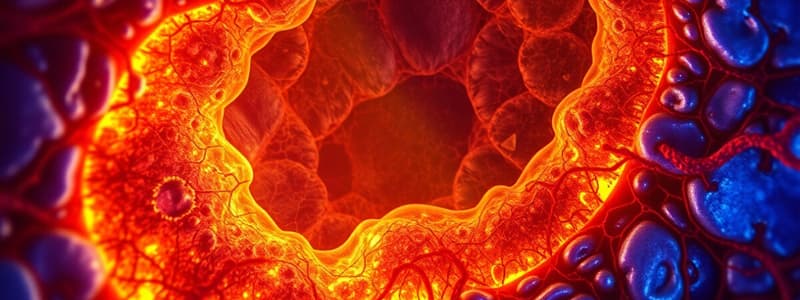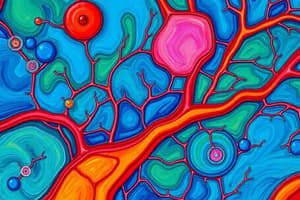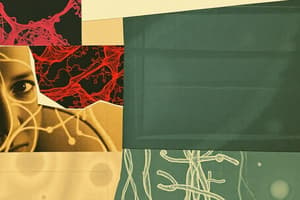Podcast
Questions and Answers
In the context of tissue regeneration, which property distinguishes labile tissues from stable and permanent tissues?
In the context of tissue regeneration, which property distinguishes labile tissues from stable and permanent tissues?
- Labile tissues exhibit minimal proliferative activity compared to stable tissues.
- Labile tissues are terminally differentiated and non-proliferative, similar to permanent tissues.
- Labile tissues are incapable of regeneration due to a lack of stem cells.
- Labile tissues consist of continuously dividing cells, enabling them to regenerate more readily. (correct)
How does liver regeneration primarily occur after significant tissue damage, and what cellular mechanisms are involved?
How does liver regeneration primarily occur after significant tissue damage, and what cellular mechanisms are involved?
- Through proliferation of neurons and glial cells.
- Through proliferation of remaining hepatocytes and progenitor cells. (correct)
- Through fibrosis and deposition of collagen.
- Through differentiation of myocardial cells into hepatocytes.
What critical role does controlled blood vessel proliferation play in tissue repair and regeneration, and how is this process regulated?
What critical role does controlled blood vessel proliferation play in tissue repair and regeneration, and how is this process regulated?
- It inhibits the migration of endothelial cells to prevent excessive angiogenesis.
- It involves the dilation of existing blood vessels, migration of endothelial cells, and recruitment of peri-endothelial cells, followed by suppression of endothelial cell proliferation. (correct)
- It promotes the formation of keloids and hypertrophic scars through abnormal fibroblastic proliferation.
- It solely relies on the deposition of extracellular matrix proteins without any cellular involvement.
Which of the following best describes the distinction between normal scarring and fibrosis in terms of cause, extent, and functional impact on tissues?
Which of the following best describes the distinction between normal scarring and fibrosis in terms of cause, extent, and functional impact on tissues?
In end-stage kidney disease, what pathological process leads to the loss of renal function, and how is this process characterized histologically?
In end-stage kidney disease, what pathological process leads to the loss of renal function, and how is this process characterized histologically?
What cellular and molecular events are essential for the formation of granulation tissue during the repair of injured tissue?
What cellular and molecular events are essential for the formation of granulation tissue during the repair of injured tissue?
How does the balance between synthesis and degradation of extracellular matrix (ECM) proteins influence the outcome of tissue repair, and what happens when this balance is disrupted?
How does the balance between synthesis and degradation of extracellular matrix (ECM) proteins influence the outcome of tissue repair, and what happens when this balance is disrupted?
What are the key differences in the regenerative capabilities of stable tissues compared to permanent tissues following injury, and what cellular characteristics determine these differences?
What are the key differences in the regenerative capabilities of stable tissues compared to permanent tissues following injury, and what cellular characteristics determine these differences?
What are the mechanisms that drive the transition from acute inflammation to fibrosis in organs such as the liver and lungs, and which specific cells are primarily responsible for this transition?
What are the mechanisms that drive the transition from acute inflammation to fibrosis in organs such as the liver and lungs, and which specific cells are primarily responsible for this transition?
How does the healing process differ in tissues undergoing repair by regeneration versus repair by connective tissue, and what are the implications for tissue function?
How does the healing process differ in tissues undergoing repair by regeneration versus repair by connective tissue, and what are the implications for tissue function?
Flashcards
Regeneration
Regeneration
Restoration of normal cells and tissue function after inflammation.
Scarring (Fibrosis)
Scarring (Fibrosis)
Replacement of damaged tissue with connective tissue, leading to scar formation.
Labile Tissues
Labile Tissues
Cells that are continuously dividing (e.g., hematopoietic cells, epithelium).
Stable Tissues
Stable Tissues
Signup and view all the flashcards
Permanent Tissues
Permanent Tissues
Signup and view all the flashcards
Repair by Connective Tissue
Repair by Connective Tissue
Signup and view all the flashcards
Granulation Tissue
Granulation Tissue
Signup and view all the flashcards
Defects in Healing
Defects in Healing
Signup and view all the flashcards
Fibrosis
Fibrosis
Signup and view all the flashcards
Examples of Fibrosis in Organs
Examples of Fibrosis in Organs
Signup and view all the flashcards
Study Notes
- After inflammation resolves, tissue repair occurs, either through regeneration or scarring
- Connective tissue or scar formation provide structural stability to injured tissue, often restoring normal organ function
Tissue Types and Regeneration
- Labile tissues have continuously dividing cells and regenerate if stem cells are present (e.g., hematopoietic cells, epithelium)
- Stable tissues exhibit minimal proliferative activity, commonly found in solid organs
- Permanent tissues are terminally differentiated, non-proliferative tissues (e.g., myocardium, brain)
Liver Regeneration
- The liver regenerates through proliferation of remaining hepatocytes or progenitor cells
- This regeneration restores normal liver function
Repair via Connective Tissue
- Injured cells are commonly replaced by connective tissue or scar tissue due to injury or inflammation
- This process involves the proliferation of epithelial cells, endothelial cells, and fibroblasts
- Granulation tissue, a combination of fibroblasts and macrophages, forms
- Connective tissue is deposited
- Regeneration and healing from inflammation require new blood vessels formed from existing ones
- The process includes dilation of existing vessels, migration of endothelial cells, recruitment of peri-endothelial cells, and suppression of endothelial cell proliferation
Fibroblastic Deposition
- Extracellular matrix proteins accompany fibroblastic differentiation during healing
- A balance exists between the synthesis and degradation of extracellular proteins in connective tissue and scar formation
Healing Defects
- Chronic wounds like venous leg ulcers, arterial ulcers, and pressure sores indicate abnormal tissue repair
- Excessive scarring includes hypertrophic scars, keloids, and wound contraction stemming from abnormal fibroblastic proliferation and scar formation
Fibrosis in Organs
- Injured or inflamed organ cellular elements heal by fibrosis
- Liver cirrhosis occurs when hepatocytes die off and are replaced by fibrous tissue
- Pulmonary fibrosis involves increased thickness of alveolar spaces and walls due to fibrous connective tissue
- Myocardial fibrosis is fibrosis in the heart tissue
- Trichrome stains of kidney, liver, and heart tissues highlight connective tissue
- As organs are injured, there is an increase in fibrous connective tissue
- End-stage kidney disease involves the replacement of renal tissue with fibrous connective tissue
Fibrosis vs. Normal Scarring
- Normal scarring is a natural part of healing after tissue injury, restoring structural integrity without significantly impairing function
- Fibrosis involves excessive scarring due to chronic injury or inflammation
- Fibrosis results in overproduction of ECM, disrupting tissue architecture and function
- Fibrosis causes organ dysfunction by replacing normal tissue with excess scar tissue like liver cirrhosis or pulmonary fibrosis
- Fibrosis exhibits excessive, progressive scarring from chronic injury, while normal scarring follows acute injuries
- Fibrosis impairs organ function, while normal scarring does not cause such extensive damage
Studying That Suits You
Use AI to generate personalized quizzes and flashcards to suit your learning preferences.




